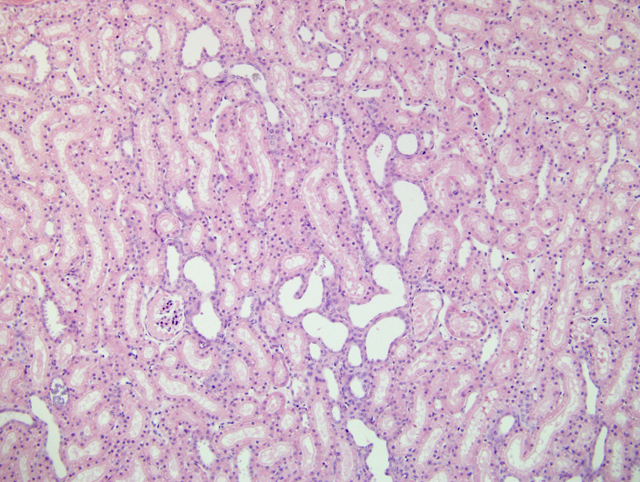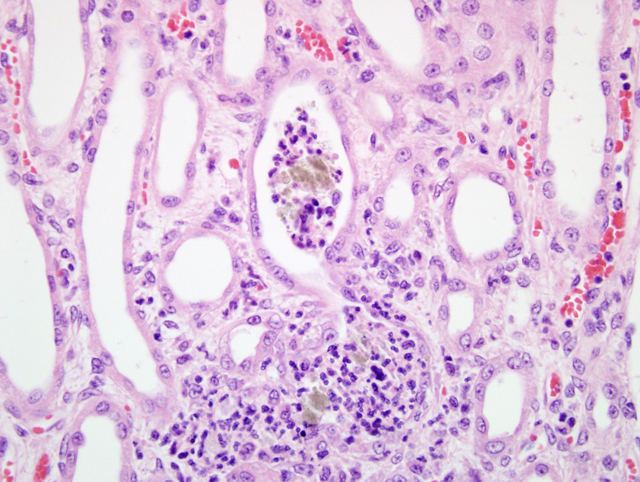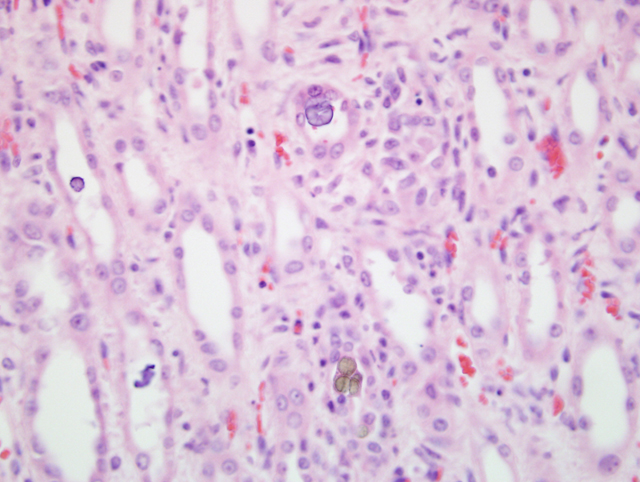Signalment:
Gross Description:
Histopathologic Description:
Morphologic Diagnosis:
Condition:
Contributor Comment:
The cat had been eating one of the pet food brands (Menu foods) which had been recently recalled from the market due to suspicion of toxic compounds in the food.6 Current thoughts regarding etiology of this pet food toxicity are focused on melamine. Melamine has been identified as a component in the wheat gluten imported from China which was a component of the recalled pet foods. Current speculation is that the melamine was intentionally added to the wheat gluten to increase the apparent protein concentration of the product. At the time of this report (April, 2007), there is no standardized toxicologic test for melamine in tissue specimens.
Acute toxicity studies of melamine in mice and rats suggest that this compound is of lower toxicity and has been rated as slightly toxic in acute toxicity ratings when administered by oral route.7 The LD50 of this compound in mice and rats are 3.3g/kg and 3.2 g/kg respectively.3,7
The pathogenesis of crystalluria and the formation of bladder stones in rodents in this syndrome is not fully understood.2,3 Melamine is excreted in the dog or rat partly as crystalline dimelaminemonophosphate. This can be isolated from warm urine by precipitation with oxalic acid as crystalline monomelaminemonooxalate.2 In experimental studies, 60-86.5 per cent of the melamine fed to dogs was recovered in the urine in 24 hours.4
JPC Diagnosis:
Conference Comment:
Up to three different crystals have been identified in the kidneys of animals affected by MARF: calcium oxalate monohydrate, calcium phosphate, and melamine-containing. On H&E, melamine-containing crystals within the lumen of renal tubules are up to 80_m in diameter, birefringent, pale yellow to brown, and vary from fan-shaped to starburst radial spokes arranged in concentric circles.4,5 Calcium oxalate crystals are also birefringent on H&E, but have a smoother surface and a slight blue tinge due to a prismatic effect.5 Calcium phosphate crystals on H&E appear as non-birefringent, basophilic particles within the lumen of renal tubules as well as within the walls of blood vessels (not apparent in the present WSC case).5 Staining characteristics of the crystals are listed below.
Staining characteristics of melamine-containing, calcium oxalate, and calcium phosphate crystals.5
| Stain | Melamine-Containing | Calcium Oxalate | Calcium Phosphate |
| Oil Red O (72 hour) | Positive | Negative | Negative |
| Von Kossa | Negative | Positive | Positive |
| Alizarin Red S (pH 4.1-4.3) | Negative | Negative | Positive |
| Hematoxylin and Eosin | Pale yellow-brown, radiating spokes, birefringent | Colorless, prismatic effect | Basophilic |
Prolonged formalin fixation results in dissolution of the melamine-containing crystals within 6 weeks.1 Therefore, it is recommend that fixation in formalin be kept to a minimum or preserved in 100% (absolute) ethanol. Although more commonly associated with cases of ethylene glycol toxicity, the calcium oxalate crystals in cases of MARF are likely the result of a secondary oxalosis.1,5
It was brought to our attention by Dr. Wayne Corapi at Texas A&M University College of Veterinary Medicine that the intratubular crystals in WSC 2004-2005, Conference 12, Case 3, are histomorphologically similar to the melamine-containing crystals recently identified in the kidneys of cats and dogs that were fed pet food on the Menu Foods recall list manufactured between December 3, 2006 and March 6, 2007. Upon reviewing the case and performing special stains, we concur with Dr. Corapi and believe it is a case of pet food-associated nephrotoxicosis with melamine-containing crystals. This association with the outbreak of renal toxicity in Asia was also reported by Puschner et al.4 and Brown et al.1 Conference participants are encouraged to review the WSC 2004-2005 case and compare it with the crystals presented in the current case.Â
References:
2. Lipschitz W, Stokey E: The mode of action of three new diuretics: Melamine, adenine and formoguanine. J Pharmacol Exp Ther 83:235-249, 1945
3. Melnick RL, Boorman GA, Haseman JK, Montali RJ, Huff J: Urolithiasis and bladder carcinogenicity of melamine in rodents. Toxicol Appl Pharmacol 72:292-303, 1984
4. Puschner B, Poppenga RH, Lowenstine LJ, Filigenzi MS, Pesavento PA: Assessment of melamine and cyanuric acid toxicity in cats. J Vet Diagn Invest 19:616-624, 2007
5. Thompson ME, Lewin-Smith MR, Kalasinsky VF, Pizzolato KM, Fleetwood ML, McElhaney MR, Johnson TO: Characterization of melamine-containing and calcium oxalate crystals in three dogs with suspected pet food induced nephrotoxicosis. Vet Path 45, 2008 (in press)
6. Pet Food Recall (Melamine)/Tainted Animal Feed. http://www.fda.gov/oc/opacom/hottopics/petfood.html originally accessed on April 23, 2007
7. NTP Acute Toxicity Studies for Melamine http://www.pesticideinfo.org/List_NTPStudies.jsp?Rec_Id=PC35459 originally accessed on April 15, 2007


